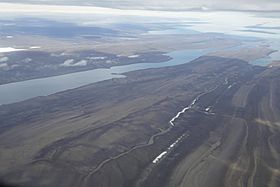Polar Bear Pass facts for kids
Quick facts for kids Polar Bear Pass |
|
|---|---|
 |
|
| Location | Bathurst Island, Qikiqtaaluk, Nunavut, Canada |
| Coordinates | 75°43′N 98°40′W / 75.717°N 98.667°W |
| Designated: | 24 May 1982 |
| Reference #: | 245 |
Polar Bear Pass is a huge natural area in Nunavut, Canada. It's a special place on Bathurst Island that includes a large wetland (a marshy area) and a mountain pass (a path through mountains). This amazing area covers about 262,400 hectares, which is bigger than many cities! It's also on land owned by the Canadian government.
Contents
Animals and Plants of Polar Bear Pass
A Cold Home for Wildlife
Even though Polar Bear Pass is in the very cold Arctic, it's a lively place! It's part of a tundra desert, which means it's very cold and dry, but still full of life. Many different animals and plants call this area home.
Birds and Insects
This wetland is a very important stop for migratory birds. These birds travel long distances and use Polar Bear Pass as a "staging area" to rest and gather food. It's also a place where many bird species come to breed and raise their young. There are lots of insects here, which are a perfect food source for all these birds!
Water and Greenery
You can find many different water features across Polar Bear Pass. There are lakes, small "tundra ponds," and wet meadows. The plants that grow here are mostly grasses, sedges (grass-like plants), mosses, and lichens. You can also find a variety of pretty flowering plants.
Research and Important Animals
There's a special research station right in Polar Bear Pass. Scientists come here to study the environment and the animals. For example, they have studied the endangered Peary caribou, which is a type of reindeer. The government is also helping to fund studies on muskoxen and other caribou in the area.
Why "Polar Bear Pass"?
The area gets its name because polar bears actually travel through it! These amazing bears migrate through the region every year, usually between March and November.
Protecting Polar Bear Pass
Polar Bear Pass is a very important natural area, so it's protected. It's recognized as an International Biological Program site, which means it's important for scientific research and conservation around the world.
It was also named a Ramsar site on May 24, 1982. Ramsar sites are wetlands that are considered very important globally, especially for waterfowl. Later, in 1985, it became the Polar Bear Pass National Wildlife Area. This special designation helps make sure this unique Arctic home for wildlife stays safe and healthy for many years to come.

